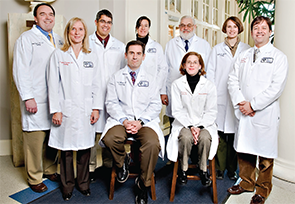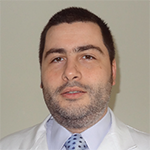
Dr. Dellaripa and Dr. Goldberg (seated), co-directors of the Interstitial Lung Disease Clinic, with additional staff members.
Co-morbidities in patients with rheumatoid arthritis and related autoimmune diseases often warrant a multidisciplinary approach to treatment. When it comes to inflammatory and fibrotic lung conditions in these patients, collaboration between pulmonary/critical care specialists and rheumatologists is essential, say two rheumatologists recently interviewed by The Rheumatologist. Both followed their rheumatology fellowship training with additional fellowships in critical care medicine. Their reasons for combining the two specialties are particular to each physician, although they both share the drive to improve their patients’ complicated co-disorders.
Capacity to Influence & Guide Care
“If you look at some of the data for lung diseases associated with the rheumatic diseases, the mortality associated with these patients approaches some types of cancer,” notes Paul F. Dellaripa, MD, co-director of the Interstitial Lung Disease Clinic and associate professor of medicine at Harvard Medical School and Brigham and Women’s Hospital, Boston. “The five-year mortality for lung disorders, such as RA or dermatomyositis, is quite high,” says Dr. Dellaripa.
Dr. Dellaripa’s choice to follow his rheumatology fellowship at Tufts University School of Medicine with one in critical care at the Lahey Clinic and Beth Israel Deaconess Medical Center arose from an initial frustration over how his rheumatology patients admitted to the ICU were handled. He had always enjoyed critical care medicine and began to contemplate pursuing an additional fellowship in that discipline. To be sure that it would be a viable career path, he took a year off and worked with another physician in critical care in a community ICU. He reports that although his mentors did not have much direct experience with combining both specialties—and there had not been anyone else pursuing both—“they encouraged me to build a new bridge between two disciplines.”
Dr. Dellaripa then practiced as a rheumatologist and critical care specialist for 11 years at Lahey Clinic, a physician-led nonprofit teaching hospital of Tufts University in Burlington, Mass. “As time went on, I began to see more and more patients whose pulmonary disorders were related primarily to their rheumatologic disease,” he recalls.
When his rheumatology patients became critically ill, he notes that many pulmonary/critical care physicians seemed uncomfortable with, or even unaware of, the unique pulmonary problems his patients presented. That’s when his interests began to shift, he says. He decided to refocus his critical care training, “which had a pulmonary bent,” and moved to Brigham and Women’s to open a lung disease clinic. Combining rheumatology with pulmonary critical care, he reasoned, “would give me the capacity to influence and guide both inpatient and outpatient care.”
Dr. Dellaripa co-founded the Interstitial Lung Disease (ILD) clinic with pulmonologist Hilary Goldberg, MD. The clinic uses a multidisciplinary model to treat patients with inflammatory and fibrotic lung disease. The staff, comprising rheumatologists, pulmonologists, pathologists and radiologists, focus on diagnosing and treating patients with ILD, providing same-day consultations and evidence-based protocols developed from the clinic’s treatment algorithm.
Nine years ago, Dr. Dellaripa initiated a lung-disease-in-rheumatology study group through the ACR, which quickly included both national and international researchers. This group has developed outcome measures particular to patients with lung and rheumatic disease and is now beginning to develop prospective trials. “The goal is to identify at-risk patients for lung disease and limit the morbidity and mortality of this complication,” he says. “When these patients get ill and end up in the ICU, their survival is not great, so early identification and intervention, when appropriate, are important.”
The Challenges of Complexity
Vladimir N. Despotovic, MD, assistant professor of medicine at Washington University in St. Louis, another dual-trained rheumatologist, first came to the U.S. in 1992 as an exchange student at the age of 17. He lived in Michigan for three years and then returned to Serbia in 1995 and enrolled in medical school in Belgrade. He returned to the U.S. in 1999 due to the political and economic environment in the Balkans.

Dr. Despotovic
Although Dr. Despotovic briefly considered a major in mathematics, he was also drawn to medicine. “Both my father and older sister are physicians, so I had great role models throughout my youth,” he says. “My sister wanted me to become an ophthalmologist like her, but I enjoyed the more broad, hands-on internal medicine approach.” His father is an internist, and it was from him that Dr. Despotovic acquired “the love of pathophysiology and immunology, which are my interests to this day.”
Once back in the U.S., he resumed his pre-med studies at Michigan State University in East Lansing. He notes that during his medical training at Wayne State University and subsequent internship and residency at Washington University, he liked most medical subspecialties and was “interested in everything.” His wide-ranging interests have been both “a blessing and a curse for me my whole career,” he says. What eventually drew him to rheumatology was the prominent part played by immunology and the clinical complexity of rheumatologic disorders. “I liked the fact that, as a medical resident, whenever we would have a complex patient, we often called rheumatology for a consult,” he says. “I wanted to be the person who understands that complexity.”
As a result, Dr. Despotovic chose a fellowship in rheumatology but also retained and continued to nurture his interest in critical care. Shortly after completing his two-year rheumatology fellowship in 1999 at Washington University, he decided to do a critical care fellowship. Combining the two was, at the time, an unusual step. “To most people, this [choice] did not look like straightforward career decision making,” he says. After completing his second fellowship, he realized that he wanted to combine both skillsets in his clinical practice. “The pace of work in the inpatient hospital environment fits me better than the outpatient environment,” he states.
Dr. Despotovic maintains that his biggest challenge was establishing his legitimacy in both fields. His immediate mentors, among them John Atkinson, MD, head of the rheumatology division, and Richard D. Brasington, MD, professor of medicine in the division of rheumatology, were “exceptional role models,” he says.
In the beginning, he perceived “an extra layer of questioning” from colleagues because the rheumatology/critical care specialist was not a defined niche. “Once people realize you can do both things with the same amount of passion, that doubt goes away.”
His current interests in the ICU environment encompass vasculitis and connective tissue disease-associated interstitial lung disease (CTD-ILD). He often interacts with his pulmonary colleagues at his institution’s ILD clinic. He finds these collaborations “a productive relationship. I think the collaboration makes us all better doctors,” he says. He also attends at his institution’s medical critical care unit in Barnes-Jewish Hospital for two-week-long blocks. If there were enough patients to warrant the volume, Dr. Despotovic quips, “the perfect position for me would be as a rheumatology intensivist.” (Indeed, in practice both he and Dr. Dellaripa do function in that role, he notes.)
The Synergy of 2 Fields
Will obtaining credentials as rheumatologists/critical care specialists become a trend? Both Drs. Despotovic and Dellaripa say it’s too early to tell. Dr. Despotovic reports that some of his trainees have inquired about following his path. “I try not to talk them into it just because I have done this,” he says. “I mention the challenges I have encountered and advise that they must have persistence. I want to make sure they are choosing the right career path for themselves.”
Dr. Dellaripa is enthusiastic about the additional synergy that has been created through the collaborations in the ILD clinic. He has also collaborated with pulmonary colleagues Aryeh Fischer, MD, and Kevin R. Flaherty, MD, to edit a new text: Pulmonary Manifestations of Rheumatic Disease, A Comprehensive Guide.
“I think it’s exciting because collaboration between pulmonary and critical care medicine and rheumatology was untapped for many years,” says Dr. Dellaripa. “We have a great consortium now of clinical investigators from both disciplines, and I think we have much to teach and learn from each other for the benefit of our patients.”
Gretchen Henkel is a medical journalist based in California.

